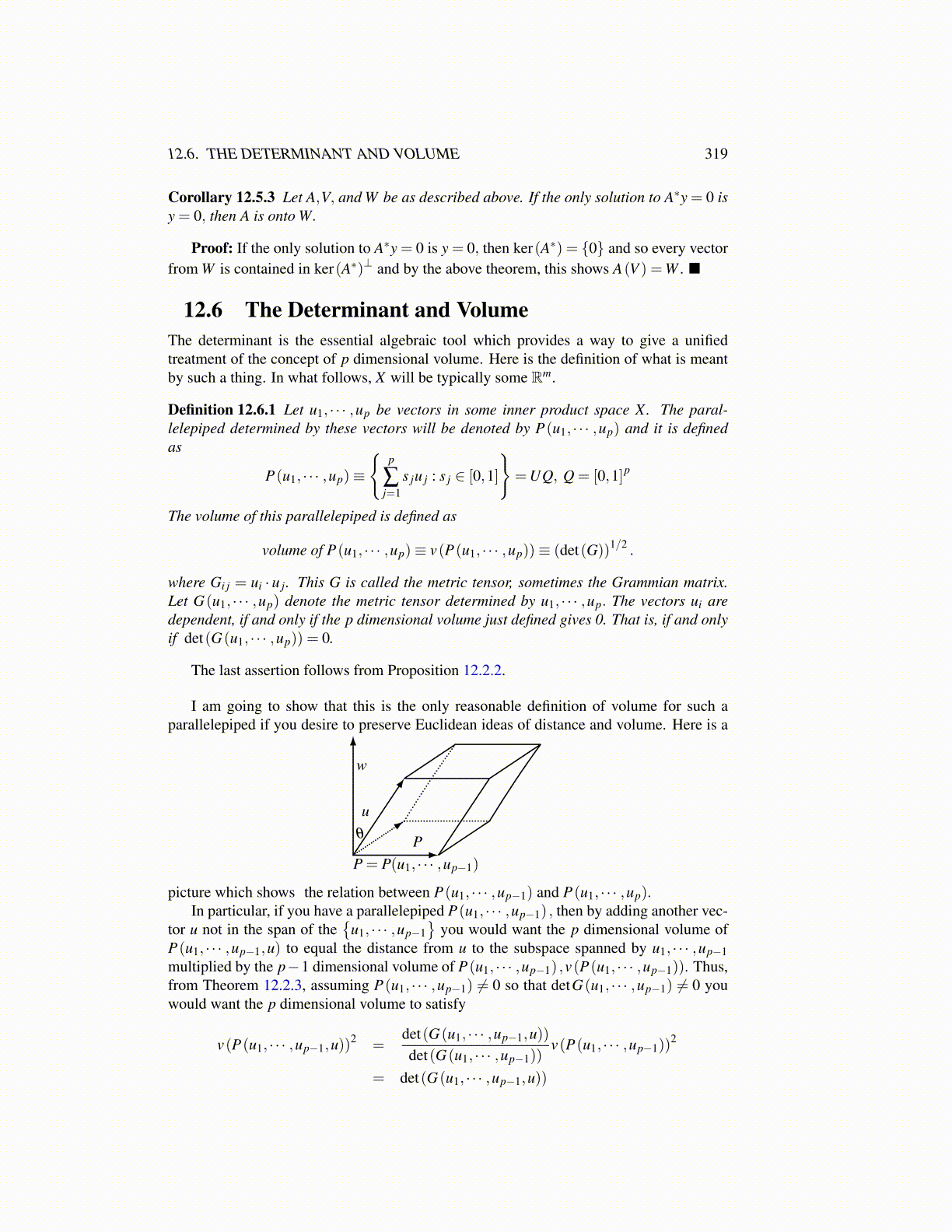
12.6. THE DETERMINANT AND VOLUME 319
Corollary 12.5.3 Let A,V, and W be as described above. If the only solution to A∗y = 0 isy = 0, then A is onto W.
Proof: If the only solution to A∗y = 0 is y = 0, then ker(A∗) = {0} and so every vectorfrom W is contained in ker(A∗)⊥ and by the above theorem, this shows A(V ) =W . ■
12.6 The Determinant and VolumeThe determinant is the essential algebraic tool which provides a way to give a unifiedtreatment of the concept of p dimensional volume. Here is the definition of what is meantby such a thing. In what follows, X will be typically some Rm.
Definition 12.6.1 Let u1, · · · ,up be vectors in some inner product space X. The paral-lelepiped determined by these vectors will be denoted by P(u1, · · · ,up) and it is definedas
P(u1, · · · ,up)≡
{p
∑j=1
s ju j : s j ∈ [0,1]
}=UQ, Q = [0,1]p
The volume of this parallelepiped is defined as
volume of P(u1, · · · ,up)≡ v(P(u1, · · · ,up))≡ (det(G))1/2 .
where Gi j = ui · u j. This G is called the metric tensor, sometimes the Grammian matrix.Let G(u1, · · · ,up) denote the metric tensor determined by u1, · · · ,up. The vectors ui aredependent, if and only if the p dimensional volume just defined gives 0. That is, if and onlyif det(G(u1, · · · ,up)) = 0.
The last assertion follows from Proposition 12.2.2.
I am going to show that this is the only reasonable definition of volume for such aparallelepiped if you desire to preserve Euclidean ideas of distance and volume. Here is a
picture which shows
P
u
w
θ
P = P(u1, · · · ,up−1)
the relation between P(u1, · · · ,up−1) and P(u1, · · · ,up).In particular, if you have a parallelepiped P(u1, · · · ,up−1) , then by adding another vec-
tor u not in the span of the{
u1, · · · ,up−1}
you would want the p dimensional volume ofP(u1, · · · ,up−1,u) to equal the distance from u to the subspace spanned by u1, · · · ,up−1multiplied by the p−1 dimensional volume of P(u1, · · · ,up−1) ,v(P(u1, · · · ,up−1)). Thus,from Theorem 12.2.3, assuming P(u1, · · · ,up−1) ̸= 0 so that detG(u1, · · · ,up−1) ̸= 0 youwould want the p dimensional volume to satisfy
v(P(u1, · · · ,up−1,u))2 =
det(G(u1, · · · ,up−1,u))det(G(u1, · · · ,up−1))
v(P(u1, · · · ,up−1))2
= det(G(u1, · · · ,up−1,u))